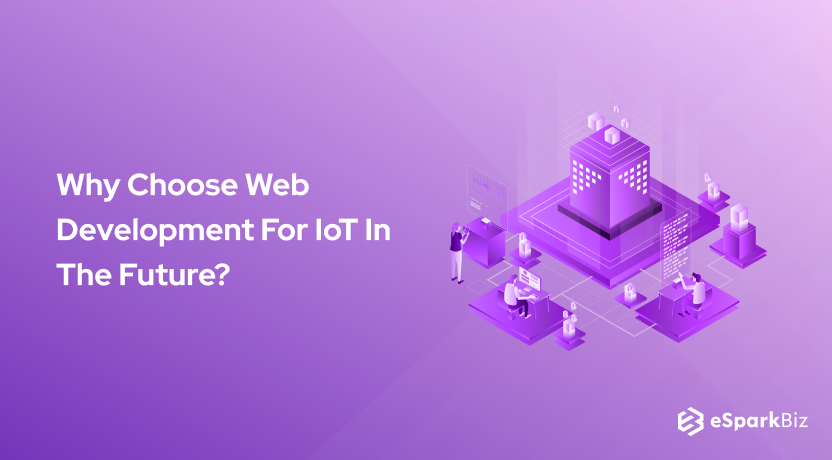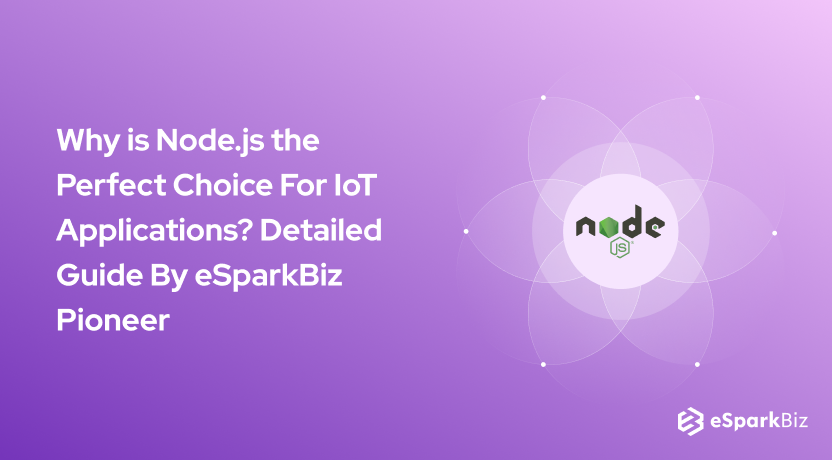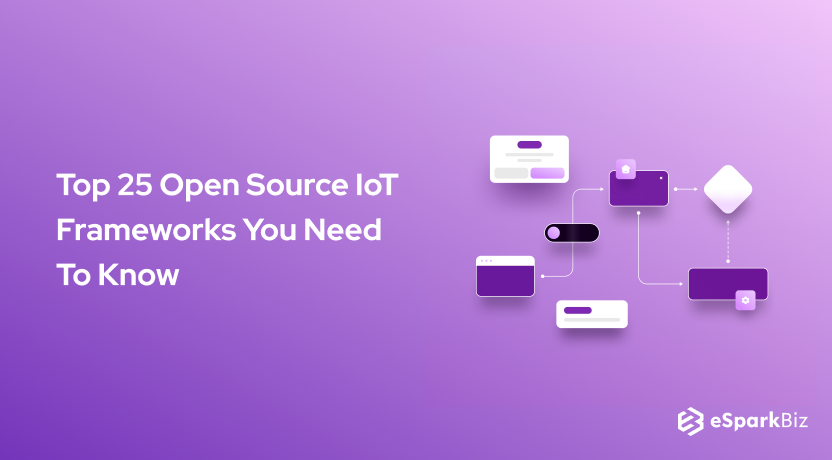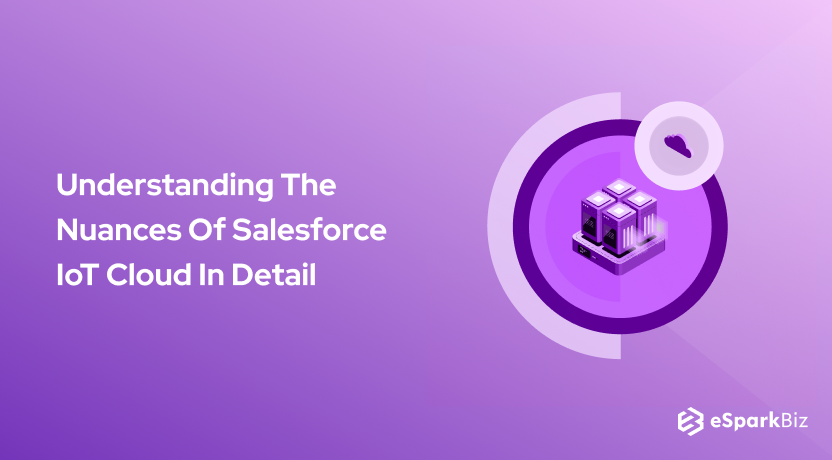In recent years, the IoT field has boomed a lot. Earlier we used to read a lot of theoretical concepts in the field of IoT, but quite recently a lot of IoT devices are now readily available in the market. Today, we will talk about Web Development For IoT in detail.
At the same time, there are advances in the field of web development also. Newer front end and back end technologies like React, Angular, and Node.js have become quite mature and are well understood. There are many Open Source IoT Frameworks to make this a reality.
You might be thinking that web Development For IoT has two completely different fields, how are they even related to each other?
But the fact is, with advancements in the field of IoT, all the sensors are now connected via the internet and all of these require a front end and backend web application. Now IoT devices are pushing Web development to the next level.
Key Things In Web Application Development For IoT
Internet of Things (IoT) means a lot of devices connected to the internet. Each of these devices has a unique address associated with it and can be used to gather and send data to the internet.
These sensors don’t require human intervention to send the data. A Leading iot application development company should keep this aspect in mind.
Few examples of IoT are Amazon Alexa, Google mini, heart monitor implant, sensors in autonomous vehicles, transponder chips.
All these devices are connected to the internet and each of them has a unique IP address associated with them using which they interact with the outside world.
A typical IoT device consists of a sensor, processor, and communication chip that collects data from the nearby environment and sends it to cloud servers.
At the cloud servers, all the data is gathered and analyzed. Based on the analysis, the data is sent back to the IoT device or any other group of sensors to act accordingly.
Some Key IoT Statistics
Let us have a look at some key interesting statistics on IoT devices.

As per the graph above, we should expect around 38.6 billion devices connected to the internet by the end of 2025.
And if you observe the graph, the increase is exponential and not linear. We should see around 75 billion devices by the year 2025.
Even, it is expected that companies would invest around$15 trillion by the end of 2025. Around 150 devices connect to the internet with a second. It’s fascinating!
It can be inferred from the above data that in the coming years, there would only be a boom and you should expect IoT to power more upcoming devices.
How IoT & Web Development Are Connected?
IoT refers to things connected to the internet and web development deals with developing front end and back end web applications.
So how Web Application Development for IoT connected to each other? We get this question a lot. And we answer that they have a deep interconnection.
Let’s make this clear by giving you an example. Amazon Alexa is an IOT device that is connected to the internet, mostly via your home Wi-Fi. As it is connected to the internet, it has an IP address associated with it.
Now when you ask Amazon Alexa to play a song, it connects with a back-end web application and plays the song.
In the above example, we see how both IoT devices and a web application come together to provide you with a seamless experience. These are some of the latest IoT Trends you should know.
Let us take one more experience but with front-end integration. We all wear smartwatches that have multiple sensors in it and tell our heartbeat, how much distance we have traveled, and how many calories we are burning.
Now, most of these devices are connected to the internet using your mobile. These devices are connected to web applications whose back-end processes our data and the front-end displays the results.
What Is an IoT Web App?
IoT Web App means the IoT device is using the web application front-end and back-end to gather data and do some analysis and display the results.
In autonomous vehicles, the sensor which measures the pressure in the tire is connected to a web application. Web Application Development for IoT is the future trend, without a doubt.!
Now when the tire pressure reduces, the sensor will inform the web application and web application will either show the data to the user or send him a notification.
Integration of Web Development in IoT
Now we have seen how IoT devices and web applications go hand in hand with each other. IoT devices can provide a much better user interface when they are connected to a web application
Below are the key factors that should be considered when integrating Web Application Development for IoT:

Compilation of Large Data
IoT devices collect real-time information and send it to the backend. As a result, the web application should be scalable. It should be able to handle a large amount of data and not only be able to handle but at the same time be able to process it also.
In applications like an autonomous vehicle, the data from these devices can be critical. So, the web application should be resilient. We cannot lose data because of the network capabilities.
We should be able to recover the data in case of a lost packet. The web application should take care of all these requirements of scalability and resilience.
These requirements increase the complexity of the web application. Companies nowadays hire a developer who has experience in these fields.
Developers who know about C, C++, NodeJS, and AngularJS are very much in demand for IoT based web application development.
Dynamic User Interfaces
Since the data gathered in IoT devices are real-time, it is important to build dynamic UI. For example, the heartbeat monitor system needs to render the heartbeat of the user every second. So, the UI should be capable of handling changes so frequently.
ReactJS and AngularJS allow you to build pages that can support dynamic rendering. React has a concept of virtual DOM using which only the affected UI component is rendered, and all other UI is kept the same. This will help you to update the UI without reloading the whole page.
Security & Privacy
The biggest concern for any IoT based system is security and privacy. We can even say 2/3rd of research in the field of IoT has been in the area of security and privacy.
All the data from the devices go to the web application via the internet. And if someone can perform a man in the middle attack or similar cryptographic attack, all the data would be compromised.
To address this issue, the OPEN WEB APPLICATION SECURITY PROJECT (OWASP) was developed in 2014. It provides important guidelines regarding the communication protocol that should be used to connect IoT devices to the internet.
You must build authentication and authorization capabilities in the web application to secure your web application against attacks.
You should encrypt the data first and then send data from the IoT device. This will increase the overhead but at the same time, it will increase the security level also.
Strong Backend Design
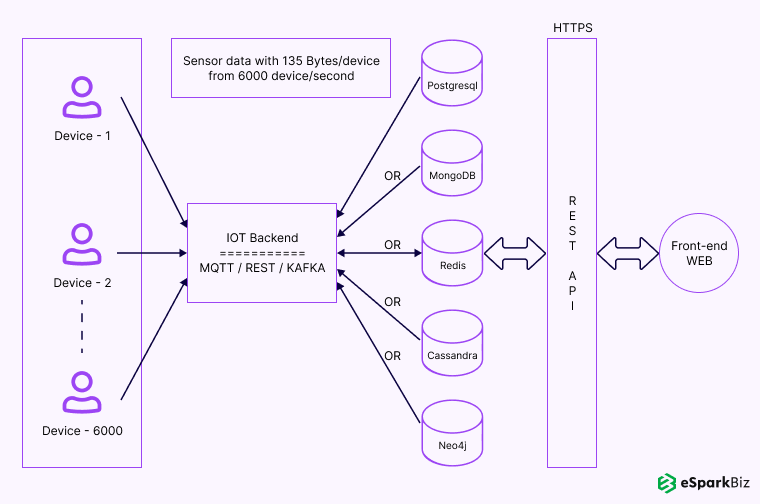
IoT devices will perform the best only if the backend is strong. The backend should be capable of handling large data requests and respond to them in real-time. Imagine the impact of even a one-second delay on autonomous vehicles.
The whole concept of IoT revolves around seamless experience. And it is only possible if we have written a strong backend. Imagine the IoT device is measuring the number of goods in your inventory.
Now as soon as one of the items in inventory is getting over, it should automatically order the item. This is the kind of seamless experience; one should expect from an IoT device.
The Future of IoT In Web Development
Web Application Development for IoT has great potential in the coming times.
Let us a look at few facts which would clearly state the importance of IoT in coming times:
- According to Cisco, only 0.06% of devices are connected to the internet. This provides a big opportunity to grow in this field and connect all the devices to build a smarter world.
- As per McKinsey, we should expect at least a saving of $36 trillion in various industries because of the productivity boost provided by the IoT ecosystem.
Latest IoT Trends in Web Development
Let’s discuss some of the top trends of Web Application Development for IoT.
- As per recent surveys, C, C++, and JavaScript are top languages to build IoT devices as well as web applications.
- C and C++ are used to write code in the device, where JavaScript is typically used for backend and communication purposes.
- Few JavaScript frameworks such as Johnny-five.io, Zetta.js are also quite popular in the space of IoT development.
Web Development Technologies & The Role of IoT
The IoT devices are almost everywhere from RFID scanners, microcontrollers, temperature controllers, sensors, Global positioning system (GPS). Most of these integrated with web applications.
But the development of web applications integrated with IoT devices is completely different as compared to developing conventional web applications.
The challenges faced are unique. Let’s have a look at a few of these challenges:
| Design consideration | Background | Issue/Problem | Solution with IoT |
|---|---|---|---|
| Data associated with the IoT device | IoT devices collect real-time data and the amount of data is large. The web application should be able to handle all the data. | The web application should be scalable enough to handle a large number of requests and at the same time, be resilient. | IoT solutions have found an elegant solution to this problem. The data is now stored in the Cloud network.
As a result, you should not worry about the data storage and can concentrate on the core logic. Developers with experience in C, C++, JavaScript are hired by a lot of organizations to build these capabilities |
| Ever-changing UI | Since the data collection and processing is interactive, the UI should render dynamically and without a glitch. | The conventional web application was designed around UI, which did not have to render every millisecond. Most of them used to render again, only after user interaction. | With newer modern JavaScript frameworks coming in the market, you can easily build interactive UI.
ReactJS comes with the concept of Virtual DOM, which allows you to render only the affected part of the screen. Developers with experience in ReactJS and AngularJS are in great demand for building IoT web application front-end. |
| Integration with Chatbots | Most organizations prefer to solve customer problems by building chatbots. | Chatbots require to understand the question and at the same time be able to find the answers | Natural Language processing comes here to rescue.
Various algorithms are designed now to provide a detailed response to a customer query. Recently OpenAI released GPT-3, which provides you with all the right algorithms. |
| Machine learning on sensors and mobile devices | With the world moving towards AI/ML, it is important to leverage these capabilities in IoT devices also. | AI/ML algorithms are very CPU extensive and eat up a lot of space. Sensors don’t come with large computing power and typically have memory in a range of Kbs. | Newer algorithms are specifically designed for building AI/ML capabilities in the sensors which have low power and fewer computing requirements.
Also, a lot of algorithms are written specifically in the backend so all the data can be collated, and the algorithms can be applied effectively. |
| Data Security | All the devices are connected to the internet, and it is important to make sure the data does not get snooped by cyber attacks | The data needs to be secured as in some scenarios it can be sensitive data. | Various algorithms are now designed which can be used to encrypt data coming from the sensor.
Hence, all the data communication to the sensor encrypted and prevented from eavesdropping. |
IoT Integrated Devices
In recent years, we have started a practical exploration of IoT. Multiple IoT devices are currently available in the market.
Let us have a look at few of those:
| Device | Details of Device | Impact | Future of the device |
|---|---|---|---|
| Smart Watch | With the sudden impact of COVID-19, people have started becoming health conscious. Everyone has started buying the watch to monitor their important vitals. | These watches are a perfect example of an IoT device. The watch has multiple sensors and all the sensors send data to the web application. The web application then shows them important data on the watch itself like how much they have walked, how much they have slept, and their heartbeat count. | There have been cutting edge innovations in the field of the smartwatch.
Apple smartwatch provides you with the ECG report. We should expect it to apply more algorithms and provide data in richer UI |
| Personal Assistants | It can help you to set up your daily tasks. | If you ask Amazon Alexa to play the song, it connects to its backend, finds the song, and then plays it on the device. Similarly, if you ask Google to create a calendar event, it will go to its web application backend and create one for you. | The teams are currently working on AI/ML technologies integrated directly in the sensor and make the sensor independent.
Also, how they are working on how they can make the user experience more personalized. |
| Microchips | All the sensors now come with microchips. For instance, in the autonomous cars, there are multiple sensors controlled by the microchip | Raspberry pi is a good example of a microchip IoT device.
Built-in a way that it can be computation extensive |
In recent years, there has been an increase in the innovation in microchips. Teams are continuously adding computation power and decreasing power usage. |
Impact of IoT on Web Development
IoT has pushed web development to its boundaries. Web Development For IoT is fine combination.
It is beyond conventional web development and requires a much more sophisticated design to build a web application for IoT devices.
Let us have a look at some of the key factors.

Increasing Bar for Entry
It is pretty clear by now; you need to learn newer technologies to build web applications for IoT devices.
Companies are now hiring developers who are not only good in C and C++ but also have good experience in writing front-end technologies. You should know most of the newer web development frameworks.
Increasing Complexity
IoT devices require a scalable and resilient web application. This brings in a lot of complexity.
You need to think out of the box most of the time to build a web application. You would need to use multiple technologies to build a scalable infrastructure.
Hybrid Development Teams
When it comes to building a web application for IoT based devices, you need a cross-functional development team.
You need engineers who understand the sensor and devices and those engineers who can write APIs so that the device and the web application can communicate.
The team should learn newer technologies as and when there is a new release.
Dynamic UI Development
IoT devices collect data in real-time. Hence, it is very important to build a UI that can render these ever-changing data.
IoT devices that use newer front-end web frameworks excel a lot in their adoption.
The UI and the UX team should be able to push to boundaries when it comes to building the UI for the IoT device.
Collecting Data Continually
As we just read, the data collection in IoT devices in real-time. Every second it collects a lot of data.
We need to make sure that these data transmitted properly to the web application and stored correctly on the backend.
Also, we need to make sure data is resilient. We should not lose data because of network connections.
Enhancing Security Features
The biggest concern in the field of IoT is security.
We need to make sure all the data encrypted, and we should also add an authorization and authentication framework in the web application.
You need to make sure only authorized persons have access to read the data. You need to use modern cryptographic algorithms to encrypt the data.
Strategies for Augmenting the IoT Roadmap
It is important to understand the advances and newer strategies developed in recent times to build a good IoT device.
| Strategy | The Future of IoT |
|---|---|
| Data abstraction | It is important to build a layer of abstraction between the device and the web application.
It allows you to simply plug new devices to the same application as you then only need to change the abstraction layer |
| Data Security | With recent advances, multiple services can perform analytics for you.
You need to talk to them regarding how they will handle personal data and the data secured on their end. |
| Network transmission and sensor design | There have been a lot of improvements recently in the network transmission protocol. Now devices are collecting a lot of data and sending it to the application.
Your data collection mechanism can turn out to be your USP and help you gain market. |
| Machine Learning | Newer algorithms designed in a way that they consume less power and space. You need to know these algorithms.
There also has been innovation in the field of NLP, which can help you design a more personalized user experience for each of their users. |
| Newer Silicon chips | Tremendous effort put in to make chips that have more memory and consume less power. They come with integrated data analytics embedded in the chips itself. |
Also Read: Why You Should Choose React For IoT?
IoT Making Web Development Back-End Focused
Eventually, IoT will start acting as the front-end, and most of the web development will take place in the backend. Most of the commercial and personal devices will connect to the internet and gather their data.
In the latest UI trends, we are moving away from the screen-based devices and moving towards the voice and hand gestures. For instance, you connect to Amazon Alexa using a voice-based mechanism.
These applications such as Alexa and Google Mini based on data analytics and all their powerful algorithms applied in the backend.
This makes it a very good case why in future Web Development For IoT focused mostly on the backend.
Conclusion
IoT is the next big trend and it is gaining a lot of popularity in recent times. In this article, we have discussed IoT and web development independently.
We have also discussed that even though these fields are independent, they are very much interrelated also. When you think of IoT, you should also think of Web Development For IoT.
We hope you had a great experience reading this article and it will help any IoT Development Firm in the future. Thank You.!
-
Why Internet of Things IoT will be successful in the coming years?
The main objective of IoT is: Everything will be connected with everyone, everywhere, all the time. The IoT future includes much better security from hacking so it will be successful in the coming years.
-
What are the main challenges of IoT?
5 big challenges still facing the Internet of Things are as follow:-
Meeting customer expectations.
Easing security concerns.
Keeping IoT hardware updated.
Overcoming connectivity issues.
Waiting for governmental regulation. -
How many IoT devices will there be in 2025?
By 2025, it is estimated that there will be more than 21 billion IoT devices.

